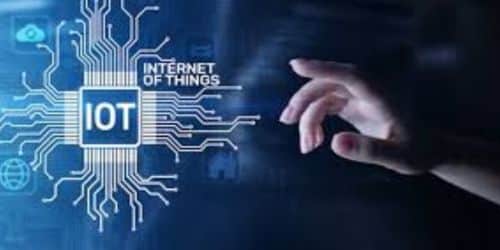The phrase “Internet of Things” and its concept originally emerged in a speech given by Peter T. Lewis in September 1985. He characterized the Internet of Things (IoT) as the fusion of individuals, procedures, and technology together with sensor-equipped, connectable items that enable remote status monitoring, modification, and trend analysis of such objects.
Overview
Over the years since the emergence of the concept, it has evolved from simple M2M(Machine to Machine) communication via specific networks without any human interference, to sensor networks of billions of smart devices connecting individuals, systems, machines, and various applications over cloud-based networks sharing data with each other.
The Internet of Things, also known as IoT, therefore now encompasses the collective network of interconnected objects and the technology that enables communication between them as well as between them and the cloud.
The Internet of Things technology helps to integrate everyday things with the Internet, these ‘Things’ are called the Internet of Things Devices and aid in operations in various sectors in which they find application.
What Is Internet of Things Technology
numerous technologies make it possible for the Internet of Things to work. The network that connects the devices in an IoT installation is essential to the field, and multiple wireless or wired systems may play this role. Together, a host of technologies come together to make the Internet of Things possible. Some of these technologies may include;
#1. Edge Computing
This is a type of IT framework technology. Edge computing helps to relocate computing resources, such as data storage, much closer to the data source, thereby reducing resource consumption, increasing computing power hence reducing communication latency and increasing average response time, enabling smart devices to perform tasks other than simply transmitting or receiving data to their IoT network. IoT edge devices, such as IoT gateways, help to do this.
#2. Connectivity
IoT devices must be online in order to send data collected by sensors and actuators to the cloud. Due to internet networking protocols, it’s easy to connect these sensors to the cloud and other “things” for data transfer.
Some of these networking technologies include;
A. Short-range wireless networks
- Bluetooth: This is a wireless standard for local area networks, allowing for the transfer of data between stable and mobile nodes over relatively short distances.
- Light-Fidelity (Li-Fi): Light-Fidelity (Li-Fi) is a form of short-range wireless communication system that uses visible light rather than the Wi-Fi standard to achieve higher bandwidth.
- Near-Field Communication (NFC): This is a set of protocols that allows two electronic devices to interact with one other within a 4 cm range.
- Radio-frequency Identification RFID: This technology uses electromagnetic fields to retrieve data from tags that are placed in other objects.
- Wi-Fi: Wi-Fi is a local area networking technology built on the IEEE 802.11 standard that enables direct communication between individual devices or communication through a common access point.
- Zigbee: IEEE 802.15.4-based personal area networking communication protocol with fast throughput, low data rates, and low battery consumption.
- Z-Wave: Z-Wave is a prominent wireless communications technology that has several applications in the home automation and safety industries.
B. Medium-range wireless networking
- LTE-Advanced – The LTE advanced, is a high-speed communication specification for cellular networks. It extends coverage, increases throughput, and decreases latency to improve the LTE standard.
- 5G –A large number of IoT devices, especially those that are always on the go, rely on 5G wireless networks for their connectivity due to their high communication needs. These three 5G features which are; enhanced mobile broadband (eMBB), massive machine type communications (mMTC), and ultra-reliable low latency communications (URLLC) are very helpful in supporting specific IoT components.
C. Long-range wireless networking
- Low-power wide-area networking (LPWAN): The term refers to low-rate, long-distance wireless networks that are efficient in terms of both power and cost. Technologies and protocols used by LPWANs include LoRaWan, Sigfox, NB-IoT, Weightless, RPMA, and MIoTy.
- Very small aperture terminal (VSAT): Here, narrowband and wideband information is broadcast via satellite with the use of relatively modest dish antennas.
D. Wired networking
- Ethernet: Ethernet is a general-purpose networking technology that uses hubs or switches along with twisted-pair cables and fiber optic lines.
- Power-line communication (PLC): This is a type of communication technology that sends data and power across electrical wiring. Specifications such as HomePlug and G.hn use PLC to network IoT devices.
#3. Cloud Computing Platforms
The Internet of Things relies on remote data storage and device management via cloud technologies to make data available to a wide variety of networked devices.
The cloud stores, processes, and analyzes the huge amounts of data that IoT devices produce. IoT application development and deployment, as well as data storage and analysis, are all made possible by cloud computing infrastructures.
#4. Sensor and Actuator Technologies
IoT sensors, also known as smart sensors, transform environmental factors into information that is readable and transferable by devices. Devices called actuators can physically alter the environment for instance, turning on or off a motor, opening or closing a valve, and other actions. Since they let machines and devices interact with the physical environment, they are at the heart of the Internet of Things.
When sensors and actuators work together to solve problems devoid of human interaction, automation is conceivable. There are numerous sorts of sensors. For instance, temperature sensors identify heat and translate variations in temperature into information. Motion monitors keep an eye on ultrasonic waves and turn them on when the waves break to identify movement.
#5. Artificial intelligence (AI) and Machine learning
IoT devices using natural language processing (NLP) make it simpler for consumers to enter data and communicate with the hardware. Amazon Alexa is a typical instance of an Internet of Things (IoT) gadget that makes use of NLP technology. Machine learning also improves IoT devices’ ability to analyze data.
The phrase “machine learning” refers to the use of computer programs and algorithms to do real-time data analysis and decision-making. You can run these machine learning techniques in the cloud or on the edge.
Businesses can acquire insights more quickly and easily due to improvements in machine learning and data analysis, as well as access to diverse and enormous volumes of data located in the cloud. The development of these complementary technologies pushes the limits of IoT, and the data generated by IoT in return, feeds these complementary technologies.
#6. Technologies for security and privacy
IoT security and privacy are becoming more and more crucial as IoT deployments spread. Cyberattacks can’t get to IoT devices or the data they receive because of things like encryption, access controls, and intrusion detection systems.
Internet of Things Applications
There are numerous consumer and industrial applications for the Internet of Things. Examples of domestic uses include home security, thermostats, and lighting fixtures. Industries and sectors which use sensor devices for their activities are likely to benefit more from Internet of Things applications.
Some common applications include;
#1. Healthcare Industry
IoT devices can be used in the healthcare sector to remotely monitor patients and gather information regarding their vital indicators, such as heart rate, blood pressure, and oxygen saturation, in real-time. By analyzing this sensor data, it is possible to spot trends and spot potential health problems before they get worse. IoT devices also serve to keep track of medical supplies, handle inventories, and see if patients are sticking to their treatments.
Another application in healthcare is asset monitoring. The precise position of patient support equipment, such as wheelchairs, is frequently necessary information for doctors, nurses, and orderlies. By fitting hospital wheelchairs with IoT devices, they can be monitored from the IoT asset-monitoring application, allowing anyone looking for one to identify the closest wheelchair right away. In order to ensure proper utilization and financial accounting for the physical assets in each department, many hospital assets can be tracked in this fashion.
#2. Manufacturing Industry
Industrial IoT devices have several applications in manufacturing, including performance monitoring, problem detection, and optimization of processes. For instance, to ensure that the environment is ideal for the creation of delicate goods, sensors can be employed, to track the temperature and humidity in a manufacturing facility.
In addition to managing supply chains, inventory, and product quality, IoT devices are also useful in tracking inventory. Industrial IoT is such a big area of new technology that it has its own acronym: IIOT, which stands for “Industrial Internet of Things.”
#3. Automotive Applications
The deployment of IoT applications has the potential to bring about major benefits for the automobile industry. In addition to the advantages of using IoT in manufacturing, sensors can identify imminent malfunctions in vehicles that are already on roadways and can provide the driver with information and suggestions. Automotive suppliers and manufacturers may learn more about how to keep vehicles running and car owners well-informed due to aggregated data gathered by IoT-based applications.
#4. Transport Applications
There are several ways that the Internet of Things can be used in the transportation sector, particularly in inter and intra – vehicular communication, smart parking, smart traffic control, toll collecting, logistics, fleet management, vehicle control, safety, and road assistance. IoT can also provide V2X, V2V, V2I, and V2P (vehicle-to-everything, vehicle-to-vehicle, vehicle-to-infrastructure, and vehicle-to-pedestrian) communication between automobiles and the transportation system.
Additionally, sensors for temperature tracking and track-and-trace might be built within the inventory itself. IoT monitoring systems that give alerts when temperatures increase or decrease to a level that threatens products during transit, would be extremely helpful to the food and beverage, floral, and pharmaceutical industries. As they frequently carry inventory that is temperature-sensitive.
IoT connectivity solutions allow cars to drive themselves, track fuel usage, and interconnect road infrastructure.
#5. Retail
Retail businesses can easily manage inventory, enhance customer service, streamline the supply chain, and cut costs by using IoT apps.
For instance, sensors can be utilized to monitor client behavior and track foot movement in a store, enabling retailers to trigger alerts for items that are running low, as well as better arrange products and enhance customer satisfaction. Supply chain management, inventory control, and shipment monitoring are all possible with the help of IoT devices.
Internet of Things Examples
The following are some common instances of Internet-of-Things devices:
#1. Smart home devices:
Smart gadgets are pieces of technology that can communicate with their users and understand what they want. Thermostats and security systems are two examples of smart home devices that can perform some tasks without human intervention. The major goals of smart home technology are to increase home efficiency and safety while also enhancing home networking.
#2. Wearable technologies:
Smartwatches are one of the most prevalent examples of the Internet of Things. Fitbits and Apple Watches use wearable IoT technologies to connect to other gadgets (like your smartphone) and share data with them. In order to track GPS locations, they frequently also connect to the internet.
#3. Autonomous Vehicles:
The internet is used by connected and self-driving automobiles to exchange real-time data. Smart dashcams, infotainment systems, or even the connected gateway in the car are some examples of how this can be done. They gather information from the fuel tanks, wheels, brakes, accelerator, speedometer, and odometer to track the health of the vehicle and the performance of the driver. A vehicle’s sensors help map its surroundings, relay video from cameras and react to traffic signals.
#4. Smart Cities and Buildings:
The application of the Internet of Things has improved the effectiveness of urban planning and infrastructure upkeep. Governments are using IoT devices to solve problems with infrastructure, health care, and the environment. IoT also finds various applications in buildings. These include; those on university campuses and in the business sector, to boost their operational efficiency.
The following are other examples;
- Autonomous farming equipment.
- Biometrics.
- Connected appliances.
- Cybersecurity scanners.
- Logistics tracking.
- Smart factory equipment.
- Ultra high-speed wireless internet.
- Wireless inventory tracking, etc.
What Is Internet of Things Security
Security and privacy are becoming more and more crucial as IoT devices multiply. Cybercriminals and other threats can put at risk the safety and security of sensitive data on many IoT devices if the right steps aren’t taken to protect them.
The process of protecting IoT devices and the networks they use is known as Internet of Things (IoT) security. Additionally, IoT security refers to precautions and defenses for cloud-connected gadgets like home automation, SCADA systems, security cameras, and other hardware which link directly to the cloud.
The key objective of IoT security is to uphold user privacy and data confidentiality, guarantee the security of equipment and other relevant infrastructures, and permit the smooth operation of the IoT ecosystem. In IoT security, information is secure as it moves from local devices to the cloud. Additionally, it safeguards the hardware from being corrupted.
Because IoT devices interact with the cloud, IoT security must also cover both the transport of data and the storage of that data.
Due to its quantity of data, use in essential industries, and reliance on it for basic operations, cybercriminals may attack the IoT. IoT already has to deal with security flaws and assaults including malware infiltration, distributed denial of service (DDoS), and data leaks. These dangers emphasize the requirement for creating robust IoT security. To be able to keep up with the IoT technology that is still developing, the strategies, techniques, and tools that makeup IoT security need to keep getting better.
What Is the Difference Between Iot and Web of Things?
The main difference between IoT and WoT is the layer at which each establishes interconnectivity between devices.
What Is Meant by Internet of Things?
The Internet of Things (IoT) describes physical objects embedded with sensors and actuators that communicate with computing systems via wired or wireless networks—allowing the physical world to be digitally monitored or even controlled.
What Is IoT and Its Examples?
The Internet of Things is a technology that allows us to add a device to an inert object (for example vehicles, plant electronic systems, roofs, lighting, etc.) that can measure environmental parameters, generate associated data, and transmit them through a communications network.
What Are the 4 Types of Iot?
The four types of IoT are;
– Consumer IoT.
– Commercial IoT.
– Industrial IoT.
– Infrastructure IoT
Conclusion
For businesses, consumers, and governments alike, the Internet of Things (IoT) is driving transformation. Emerging devices and innovations like smart speakers, machine learning, and 5G are offering significant increases in productivity and more control at home and at work.
The Internet of Things has numerous applications in the realms of industry, daily life at home, and citywide smart infrastructure. Increased productivity, security, and time management are a few of these benefits. Be that as it may, there are still questions about IoT security as more work needs to be done in securing IoT devices and data collected using these devices in order to ensure a robust IoT ecosystem.
What Is Internet of Things FAQs
What Is Internet of Things and Its Benefits?
Some benefits of IoT include;
– Improved productivity of staff and reduced human labor.
– Efficient operation management.
– Better use of resources and assets.
– Cost-effective operations.
– Improved work safety.
What Is Another Word for Internet of Things?
Smart systems are another name for the Internet of Things.
Is Netflix an Iot?
Netflix in itself is not an IoT, but makes use of information gathered from IoT devices.






